Welcome to our comprehensive guide on Alternanthera Variegatus, a stunning plant that will bring a vibrant splash of color to your aquatic garden.
With its variegated foliage and ability to thrive in water settings, Alternanthera Variegatus is the perfect choice for creating a visually appealing water garden.
Let us take you on a journey through the beauty and versatility of this remarkable plant.

Key Takeaway
- Alternanthera Variegatus is a colorful plant with variegated foliage, making it a beautiful addition to any aquatic garden.
- It thrives in water settings, making it an excellent choice for water gardens and other aquatic landscaping projects.
- Alternanthera Variegatus adds visual interest to aquascaping, allowing you to create stunning color contrasts and combinations.
- Caring for Alternanthera Variegatus in aquatic settings involves providing the right water conditions, lighting, and general plant maintenance.
- This plant can be propagated through various methods, such as stem cuttings, division, and seeds, allowing you to expand your collection.
Quick Stats
| Attribute | Value |
| Family Name | Amaranthaceae |
| Origin | South America |
| Height | 10-20 cm (4-8 inches) |
| pH Range | 6.0-7.5 |
| CO2 Requirement | Moderate to High |
| Growth Rate | Fast |
| Care Level | Moderate |
| Color Form | Green, Pink, Red |
| Water Conditions | Soft to Medium, 22-28°C |
| Max Size | 20-30 cm (8-12 inches) |
| Lighting | Moderate to High |
| Supplements | Iron-rich fertilizers |
| Placement | Midground to Background |
| Propagation | Cuttings, Side shoots |
Overview
Welcome to our guide on Alternanthera Variegatus, a stunning aquatic plant that will bring a splash of color to your water garden.
In this section, we will introduce you to Alternanthera Variegatus and explore why it is the perfect choice for your aquatic garden. Let’s dive in!
What Is Alternanthera Variegatus?
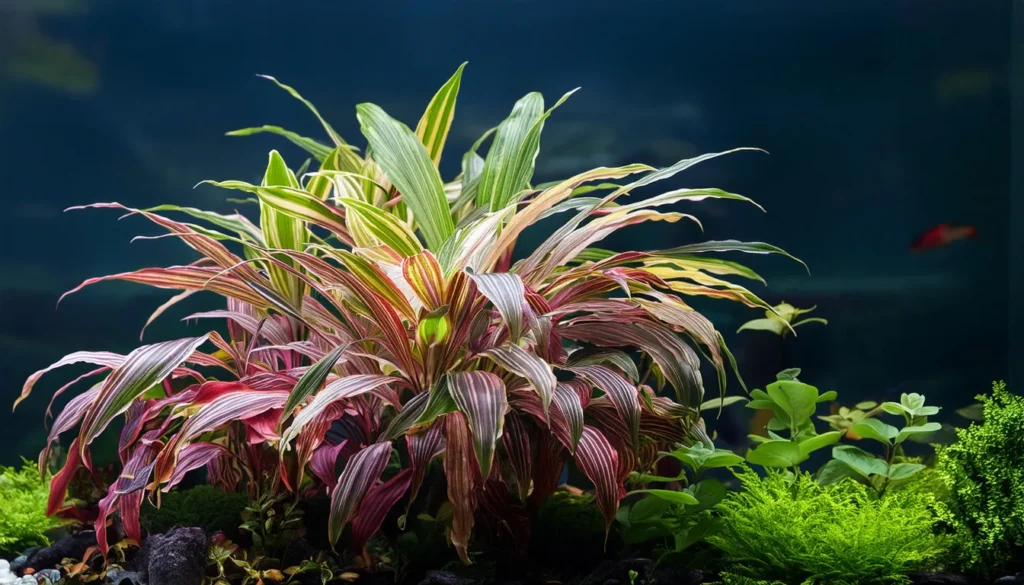
Alternanthera Variegatus, also known as the variegated joyweed, is a versatile aquatic plant that adds a touch of elegance and vibrancy to any water garden.
With its distinctive variegated foliage featuring shades of green, pink, and purple, Alternanthera Variegatus stands out among other aquatic garden plants.
This popular species belongs to the amaranth family and is native to various tropical regions around the world.
Its stunning colors and unique leaf patterns make it a favorite among water gardening enthusiasts.
Why Choose Alternanthera Variegatus For Your Aquatic Garden?
Alternanthera Variegatus is a top choice for aquatic gardeners due to its numerous benefits and striking visual appeal.
Here are some reasons why you should consider incorporating Alternanthera Variegatus into your water garden:
- Stunning Variegated Foliage: The variegated leaves of Alternanthera Variegatus create a mesmerizing display of colors, adding visual interest and beauty to your water garden.
- Easy Water Gardening: This aquatic plant is well-suited for water gardening, as it can thrive in both shallow and deep water settings, allowing for versatile placement and design options.
- Versatile Landscaping: Alternanthera Variegatus is not limited to water gardens. Its adaptable nature makes it suitable for various landscaping applications, such as creating borders, edging pathways, or adding accents to your outdoor garden.
- Low Maintenance: Maintaining Alternanthera Variegatus is relatively easy. It requires minimal pruning, can tolerate a wide range of temperatures, and is generally resistant to pests and diseases.
- Plant Diversity: Incorporating Alternanthera Variegatus into your aquatic garden adds diversity and texture, complementing other aquatic plants and creating a visually dynamic and balanced ecosystem.
The Aesthetic Appeal In Aquascaping
Aquascaping is more than just creating a visually stunning water garden; it is an art form that allows you to design and cultivate a captivating underwater landscape.
Alternanthera Variegatus, with its vibrant colors and unique foliage, is an excellent choice for adding aesthetic appeal to your aquascape.
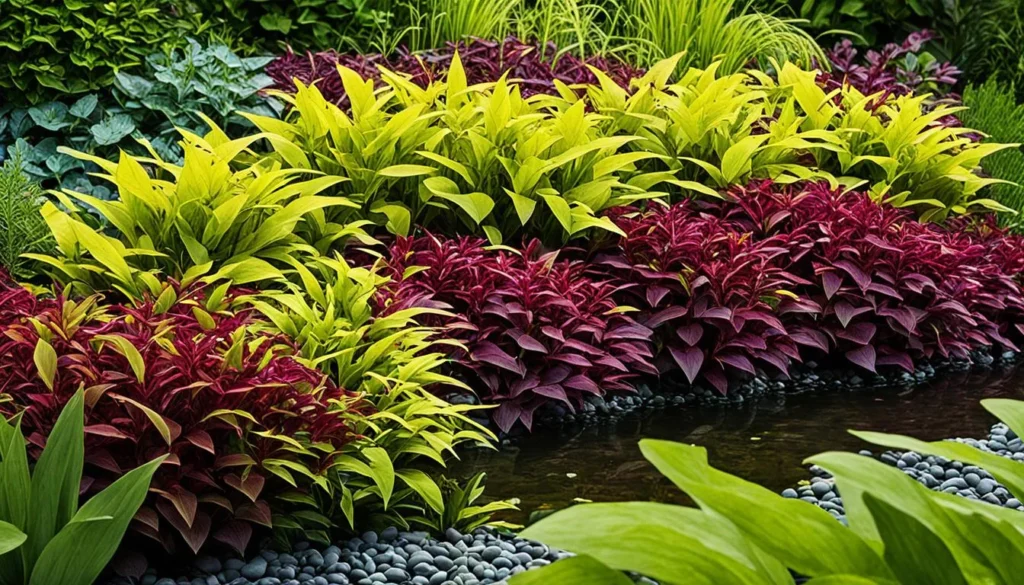
Alternanthera Variegatus, with its variegated leaves displaying a beautiful combination of green, pink, and red hues, immediately draws attention in any aquascape. The contrasting colors create a visually striking appearance that can become the focal point of your underwater garden.
By strategically placing Alternanthera Variegatus in your aquascape, you can enhance visual interest and create dynamic focal points.
Use this plant as a centerpiece or to highlight specific areas of your underwater landscape, adding depth and dimension to the overall design.
Color Contrasts And Combinations
- One of the advantages of using Alternanthera Variegatus in aquascaping is its versatility when it comes to color contrasts and combinations. Whether you prefer a harmonious color scheme or a bold, contrasting palette, this plant offers endless opportunities to play with color in your aquascape.
- Pair Alternanthera Variegatus with plants that have complementary colors, such as green or purple aquatic plants, to create a harmonious look. The contrasting colors will add depth and make each plant stand out, creating a visually captivating underwater display.
- If you prefer a bolder approach, combine Alternanthera Variegatus with plants in contrasting colors like yellow or blue. This striking contrast will create a dramatic visual impact and add vibrant color to your aquascape.
- Experiment with different plant combinations to find the perfect balance of colors in your aquascape. The contrasting hues of Alternanthera Variegatus can also be used to highlight other elements in your aquascape, such as rocks, driftwood, or decorative features, further enhancing the overall visual appeal.
RELATED: Unraveling The Helanthium Vesuvius Spirals Of Aquatic Beauty
Alternanthera Care In Aquatic Settings
To ensure the health and vitality of your Alternanthera Variegatus plant in aquatic settings, it is important to provide the proper care and maintenance. Here are some key factors to consider:
- Water requirements: Alternanthera Variegatus thrives in moist environments, so it is imporkeepingonsistently damp. Avoid all is importantowing the plant to sit in soggy conditions, as this can lead to root rot.
- Lighting needs: This aquatic plant prefers bright, indirect light, so placing it near a window or under grow lights will promote healthy growth. However, direct sunlight should be avoided as it can cause leaf burn.
- Temperature preferences: Alternanthera Variegatus prefers moderate temperatures between 65-80°F (18-27°C). Avoid exposing the plant to extreme temperatures or drafts.
- General maintenance tips: Regularly check the water level and ensure it is adequate to keep the soil moist. Prune any dead or yellowing leaves to maintain a tidy appearance. Additionally, consider adding a layer of mulch or pebbles to help retain moisture and prevent weed growth.
Stem Cuttings For Propagating Althernanthera Varuegatus
One of the most common and effective propagation methods for Alternanthera Variegatus is through stem cuttings. Follow these steps to propagate your plant using stem cuttings:
- Cut a healthy stem from the parent plant using a sharp, clean pair of scissors or pruning shears. The stem should be approximately 4-6 inches long.
- Remove the leaves from the lower half of the stem, leaving a few leaves at the top for photosynthesis.
- Fill a small container with a well-draining aquatic planting medium.
- Make a small hole in the planting medium and insert the cut end of the stem into the hole.
- Gently press the soil around the base of the stem to secure it in place.
- Place the container in a well-lit area with indirect sunlight.
- Keep the soil consistently moist but not waterlogged.
- Within a few weeks, you should start to see roots forming at the base of the cutting.
- Once the new plant has developed a strong root system, it can be transplanted into a larger container or directly into a water garden.
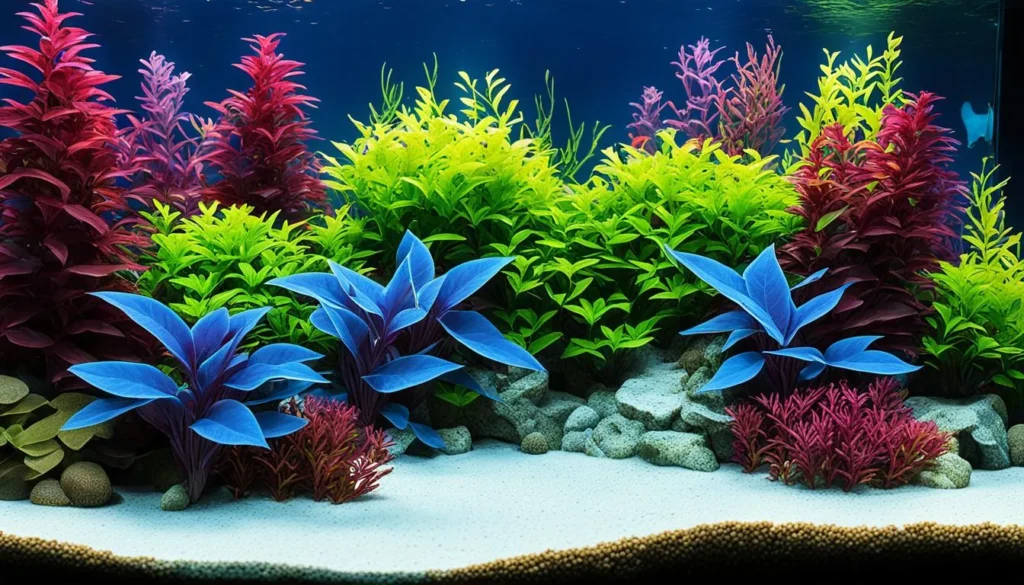
Division
Another propagation method for Alternanthera Variegatus is through division. This method is best done when the plant has grown large enough to have multiple stems and is actively growing. Follow these steps to divide your plant:
- Carefully remove the plant from its container or water garden.
- Gently separate the roots and stems into individual sections, ensuring that each section has sufficient roots and foliage.
- Trim any damaged or unhealthy roots or foliage.
- Plant each divided section in a separate container or directly into the water garden.
- Provide adequate water and light to the newly divided plants, ensuring they are well cared for as they establish new root systems.
Seeds
Alternanthera Variegatus can also be propagated from seeds, although this method requires more time and patience. Here’s how to propagate your plant using seeds:
- Collect ripe seeds from the parent plant.
- Fill a small container with a well-draining aquatic planting medium.
- Sprinkle the seeds onto the surface of the soil.
- Lightly press the seeds into the soil, ensuring they are in contact with the planting medium.
- Mist the soil lightly with water to keep it consistently moist.
- Place the container in a warm, well-lit area.
- Keep the soil moist and be patient, as germination can take several weeks.
- Once the seedlings have developed strong root systems and are large enough to handle, they can be transplanted into bigger containers or directly into the water garden.
Alternanthera Varieties For Diverse Aquatic Landscapes
When it comes to creating captivating aquatic landscapes, the choice of plant varieties plays a crucial role. Alternanthera offers a wide range of options that can bring vibrancy and diversity to your water garden.
In this section, we will explore popular Alternanthera species, highlighting their unique features and characteristics.
Additionally, we will provide recommendations for selecting the right variety based on different water garden themes and design concepts.
Comparison Of Popular Alternanthera Species
There are several notable Alternanthera varieties that stand out for their visual appeal and adaptability to water garden settings. Let’s take a closer look at some of these popular species:
- Alternanthera ficoidea ‘Red Threads’: This variety features thin, red-colored foliage that contrasts the surrounding plants. Its slender and elongated leaves create a unique texture, making it a standout choice in aquatic landscapes.
- Alternanthera reineckii: This species is known for its stunning red to purplish leaves. It can create a bold focal point in your water garden, especially when combined with other green or variegated plants. Alternanthera reineckii also has a bushy growth habit, which adds volume and texture to the overall landscape.
- Alternanthera reineckii ‘Mini’: If you’re looking for a compact variety with a vibrant color palette, Alternanthera reineckii ‘Mini’ is an excellent choice. Its small, oval-shaped leaves display shades of red, pink, and orange, creating a visually stunning mosaic. This species is ideal for creating intricate patterns or borders in your aquatic landscape.
Choosing Varieties For Different Water Garden Themes
When selecting Alternanthera varieties for your water garden, it’s essential to consider the overall theme and design concept you want to achieve. Here are some recommendations based on specific water garden themes:
- Naturalistic Theme: For a naturalistic water garden, consider using Alternanthera ficoidea ‘Red Threads’ and other grass-like or fern-like plants. This combination will emulate the vibrant diversity of a lush, tropical environment.
- Modern Contemporary Theme: Alternanthera reineckii, with its bold red leaves, can add a modern and dramatic touch to your water garden. Pair it with minimalist features and clean lines for a sleek and sophisticated aesthetic.
Colorful and Whimsical Theme: Alternanthera reineckii ‘Mini,’ with its vibrant shades of red, pink, and orange, is perfect for creating a cheerful and whimsical water garden. Combine it with other colorful aquatic plants and decorative elements for a playful and enchanting atmosphere.
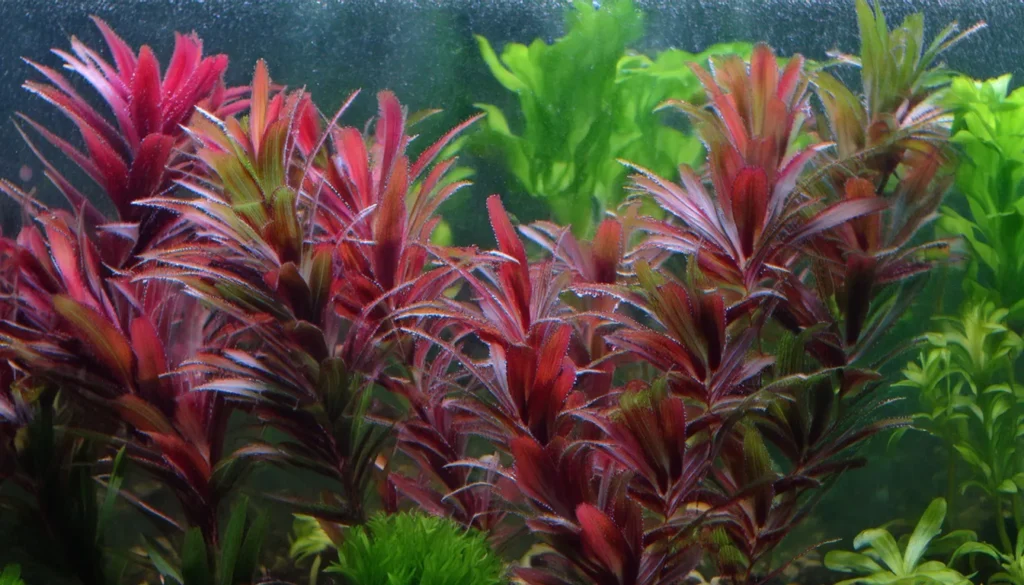
Alternanthera Landscaping Beyond The Water Garden
While Alternanthera Variegatus is undoubtedly a stunning addition to any water garden, its versatility extends beyond aquatic settings. This ornamental plant can also be used to enhance the beauty of various other landscaping environments, offering endless possibilities for outdoor gardening enthusiasts.
When it comes to incorporating Alternanthera Variegatus into your outdoor garden, the options are almost limitless. The plant’s vibrant and variegated foliage adds color and visual interest to any landscape design.
Whether you’re looking to create stunning borders, fill containers, or add unique accents to your garden beds, Alternanthera Variegatus is a go-to choice for its versatility and aesthetic appeal.
Here are a few landscaping ideas to inspire you:
- Alternanthera Variegatus is a colorful ground cover in rock gardens or pathways.
- Alternanthera Variegatus as a border plant to create striking color contrasts.
- Alternanthera Variegatus is a focal point in container plantings, either alone or combined with complementary flowers.
- Alternanthera Variegatus is a vibrant addition to garden beds or mixed borders, providing a dynamic backdrop for other ornamental plants.
When integrating Alternanthera Variegatus into your landscaping, consider its plant versatility. Its contrasting colors and unique leaf shapes create endless opportunities to experiment with different plant combinations and create visually captivating arrangements.

Design Strategies For Maximum Impact
To create a visually stunning display with Alternanthera Variegatus, consider the following design strategies:
- Contrasting Colors: Pair Alternanthera Variegatus with contrasting plants to create a vibrant and eye-catching display. For example, the rich purple hues of Alternanthera Variegatus can be beautifully complemented by plants with bright yellow or white flowers.
- Texture Variety: Incorporate plants with different textures to add depth and interest to your garden design. Combining the fine, delicate foliage of Alternanthera Variegatus with plants that have larger, more robust leaves can create a visually dynamic and harmonious arrangement.
- Height Variation: Play with varying heights to create a multi-dimensional planting design. Alternanthera Variegatus, with its low-growing habit, can be used as a border or groundcover plant to provide a lush and colorful backdrop for taller plants or architectural features.
Ideal Planting Companions
When selecting planting companions for Alternanthera Variegatus, consider plants that share similar growing conditions and complement their vibrant colors. Here are some ideal planting companions:
- Caladiums: These tropical plants, with their large, colorful leaves, create a stunning contrast when planted alongside Alternanthera Variegatus.
- Marigolds: The bright yellow and orange flowers of marigolds contrast the purple foliage of Alternanthera Variegatus.
- Coleus: With their vibrant and varied leaf patterns, coleus plants make an excellent companion for Alternanthera Variegatus, creating a visually appealing tapestry of foliage.
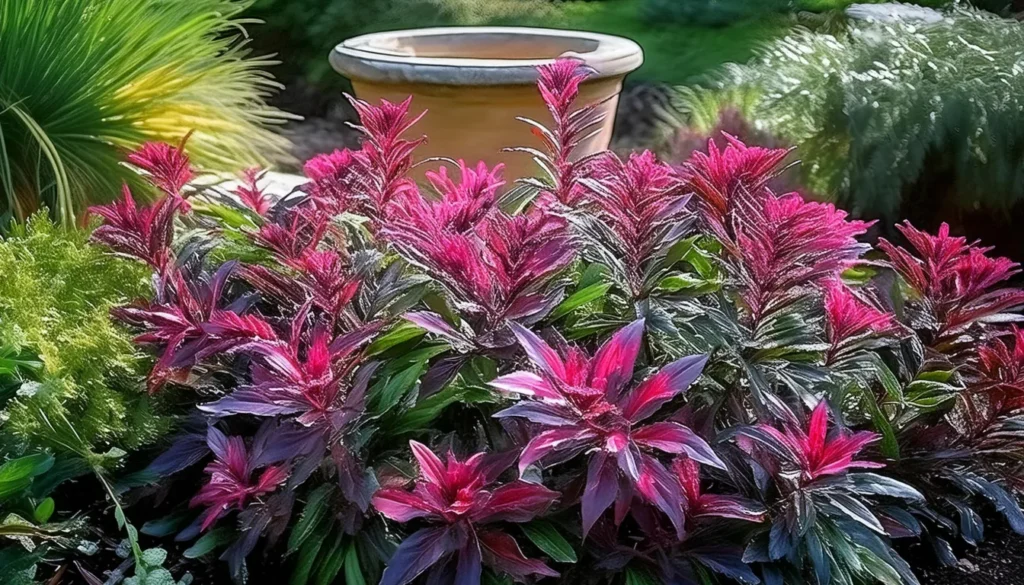
Seasonal Care For Lasting Vibrancy
In order to maintain the lasting vibrancy of your Alternanthera Variegatus plants throughout the year, it is important to provide proper seasonal care. By following a few key guidelines, you can ensure your water garden plants’ health, vitality, and beauty.
Pruning
- Regular pruning is essential for maintaining the shape and size of your Alternanthera Variegatus plants.
- Trim back any overgrown or straggly branches to encourage new growth and maintain a compact form.
- Pruning also helps to improve air circulation and reduce the risk of disease.
Fertilization
- Proper fertilization is crucial for the overall health and growth of Alternanthera Variegatus. Use balanced aquatic plant fertilizer to provide essential nutrients during the growing season.
- Follow the manufacturer’s instructions for application rates and frequency to avoid overfertilization, which can lead to algae blooms and harm the plants.
Protection From Extreme Weather Conditions
- Alternanthera Variegatus plants are sensitive to extreme weather conditions such as frost or excessive heat. During cold spells, providing protection by covering the plants or moving them to a sheltered area is important. In hot summer, ensure the plants have adequate shade and moisture to prevent wilting and sunburn.
- Proper seasonal care, including pruning, fertilization, and protection from extreme weather, is essential for maintaining the health and vibrancy of your Alternanthera Variegatus plants throughout the year.
RELATED: Alternanthera Bettzickiana Green Planting Detailed Guide
Understanding The Native Environment
- Alternanthera Variegatus is native to tropical and subtropical regions, where it thrives in diverse habitats such as wetlands, marshes, and riverbanks. These natural environments provide valuable clues about the plant’s ideal growing conditions.
- They typically consist of rich, moist soils with good drainage, ample sunlight, and a consistent water supply. By replicating these environmental factors in our aquatic gardens, we can create a habitat that resembles the plant’s native home.
Adapting Care Practices Based On Natural Growth Patterns
- Observing Alternanthera Variegatus’s natural growth patterns in its native habitats can guide us in adapting our care practices to promote optimal plant health and growth. For example, the plant’s adaptation to wetland environments suggests a tolerance for high humidity and regular watering. Mimicking these conditions in our aquatic gardens through appropriate water management and humidity control can help ensure the plant’s flourishing vitality.
“By studying Alternanthera Variegatus’ natural habitats and taking inspiration from its native environment, we can create an aquatic garden that meets the plant’s specific needs, resulting in a vibrant and thriving display.”
- Overall, understanding Alternanthera Variegatus’s natural habitats provides valuable insights into the plant’s preferences and requirements. By incorporating these lessons into our care practices, we can create the ideal environment for this beautiful aquatic plant to thrive.
Addressing Common Pests And Diseases In Alternanthera
Ensuring the health and vitality of your Alternanthera Variegatus plants is crucial for maintaining a vibrant aquatic garden.
In this section, we will discuss common pests and diseases that can affect Alternanthera and provide valuable information on identifying and managing these issues effectively.
Pest Management
- Regularly inspect your plants for signs of pest infestation, such as small holes in leaves, webs, or sticky residue.
- Common pests that may challenge Alternanthera include aphids, mealybugs, and spider mites.
- To manage infestations, organic pest control methods like manual removal, neem oil, or insecticidal soaps.
Plant Diseases
- Alternanthera may be susceptible to fungal infections like powdery mildew and leaf spot diseases.
- Ensure proper air circulation and avoid overwatering to minimize the risk of fungal diseases.
- If necessary, apply fungicides according to the manufacturer’s instructions to control fungal infections.
To maintain plant health and prevent pest and disease issues, it’s essential to practice good plant care and hygiene:
- Regularly remove dead or decaying plant material from the water garden to discourage pests and diseases.
- Provide adequate sunlight and optimal growing conditions for Alternanthera Variegatus.
- Monitor plant health closely and take prompt action at the first sign of pest or disease problems.
Importance Of Water Parameters
The water parameters in your aquatic garden play a crucial role in the overall health and well-being of Alternanthera Variegatus. Consider the following key factors when maintaining water quality:
- Temperature: Alternanthera Variegatus thrives in temperatures between 72°F and 82°F (22°C and 28°C).
- pH Level: Maintain a pH level between 6.0 and 7.5, as this range is ideal for the plant’s growth and nutrient absorption.
- Hardness: Alternanthera Variegatus prefers water with moderate hardness, around 3 to 8 dKH.
- Ammonia and Nitrate Levels: Monitoring and controlling ammonia and nitrate levels in your water garden is crucial, as excessive amounts can harm the plant’s health.
A Guide To Fertilizing Aquatic Plants
Fertilization is essential for providing the necessary nutrients for Alternanthera Variegatus’ growth and development. Follow this guide for effective fertilization:
- Choose the Right Fertilizer: Select a high-quality aquatic plant fertilizer specifically formulated for water gardens. Look for a fertilizer that provides essential nutrients such as nitrogen, phosphorus, and potassium.
- Follow the Instructions: Read and follow the instructions on the fertilizer packaging carefully. Each product may have specific guidelines for dosage and application frequency.
- Apply Fertilizer Sparingly: Avoid over-fertilization, as it can lead to algae growth and other water quality issues. Start with a small amount and gradually increase if necessary.
- Time the Application: Apply the Fertilizer during the plant’s active growth period for maximum absorption. Depending on the product, this may be once a month or less frequently.
- Distribute Evenly: Spread the Fertilizer evenly throughout your aquatic garden or target the root zone of Alternanthera Variegatus. This ensures that all plants receive the necessary nutrients.
Conclusion
Alternanthera Variegatus is a remarkable aquatic plant that brings a vibrant splash of color to water gardens. With its stunning variegated foliage, this plant adds visual interest and enhances the overall aesthetics of your aquatic garden.
Whether you’re an experienced aquatic gardener or a beginner, Alternanthera Variegatus is an excellent choice due to its versatility and ease of care.
By incorporating Alternanthera Variegatus into your water garden, you can enjoy various colors and textures that will captivate and delight you for years to come.
It’s vibrant hues and unique patterns provide endless possibilities for creating stunning color contrasts and combinations in your aquascape designs.
Frequently Asked Questions
How Do I Maintain The Variegation In Alternanthera ‘variegatus’ Leaves Under Aquarium Conditions?
Maintaining the variegation in Alternanthera ‘Variegatus’ requires balanced lighting and nutrient levels. Variegation can be more pronounced under medium to high lighting conditions, but too much light can cause the plant to lose its unique pattern in favor of more chlorophyll production (greener leaves) for photosynthesis.
Ensure a regular supply of essential nutrients, particularly iron, to promote vibrant leaf coloration while avoiding excess nitrogen, which can encourage more green growth.
What Specific Substrate Requirements Does Alternanthera ‘variegatus’ Have For Optimal Growth?
Alternanthera ‘Variegatus’ thrives in a nutrient-rich substrate that facilitates easy root penetration and nutrient uptake. A mixture of fine gravel with an underlying layer of aquatic plant soil or a commercial planted tank substrate enriched with minerals and nutrients supports healthy root development.
Incorporating root tabs near the plant’s base can also provide a direct nutrient source, encouraging vigorous growth and vibrant variegation.
Can Alternanthera ‘variegatus’ Adapt To Different Water Parameters, And How Does It Affect Its Variegation And Growth?
Alternanthera ‘Variegatus’ is relatively adaptable to a range of water parameters but prefers slightly acidic to neutral pH (6.0-7.0) and soft to medium hardness. Extreme deviations from these conditions may stress the plant, potentially affecting its growth rate and the intensity of its variegation.
Regular water testing and adjustments, if necessary, help maintain an environment conducive to preserving the plant’s distinctive appearance.
What Advanced Techniques Can Be Used To Propagate Alternanthera ‘variegatus’ Effectively In An Aquarium?
Effective propagation of Alternanthera ‘Variegatus’ can be achieved through stem cuttings. Select healthy stems and cut them just above a leaf node. Remove the lower leaves and plant the stem cuttings into the substrate, ensuring at least two nodes are buried to facilitate root growth.
High lighting and CO2 supplementation during the initial stages post-propagation can enhance the success rate and encourage robust growth in the cuttings.
How Do I Manage And Prevent Common Pests And Diseases In Alternanthera ‘variegatus’ Without Compromising Its Variegation?
Managing pests and diseases in Alternanthera ‘Variegatus’ involves maintaining optimal tank conditions to strengthen plant health, as healthier plants are less susceptible to issues. Quarantine new plants to prevent the introduction of pests.
If pests are detected, manual removal or targeted treatments with aquarium-safe pesticides can be effective. For diseases, improving water quality and tank hygiene is crucial. Use treatments specifically labeled safe for planted tanks to avoid harming the plant.
Regularly inspect the plant for signs of stress or infection and address issues promptly to prevent spread.
- Unveiling The Wonders Of Riccia Fluitans In Aquascapes - August 7, 2024
- Vallisneria Gigantea Var. Guide To Care And Cultivation At Home - July 31, 2024
- Vesicularia Dubyana Care & Growth Guide Tips For Beginner Gardeners - July 30, 2024
